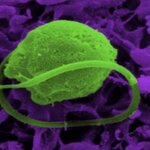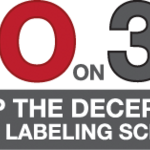Genetics & Molecular Biology

Bread wheat (Triticum aestivum) accounts for 20% of the calories consumed by the entire world and is one of the Big Three globally important crops, along with rice and corn.
A few months after we got barley deciphered, an international effort has completed the technically daunting task of sequencing the bread wheat genome - its constituent number of paired DNA bases, or nucleotides, totals 17,000,000,000 base-pairs (17 Gb), about five times the amount of DNA in the human genome, and it is a hexaploid genome, which means it has six copies of each of its seven chromosomes, the…

Millions of years ago, tiny animal thieves going by the alias protozoa held algae captive and then exploited and stole their genes for energy production, thereby evolving into a new and more powerful species.
But the little protozoan outlaws couldn't completely hide all evidence of the captive algae and have been effectively frozen in time - and then caught in the act by genetic sequencing.
The protozoa captured genes for photosynthesis, the process of harnessing light to produce energy which is used by all plants and algae on earth. Scientists assume that quantum leaps of evolution…

It used to be a stereotype that being fat meant you had a happy personality. Then culture went out of its way to vilify fat people and make them miserable - when they weren't vilifying culture or food companies for making people fat.
Now researchers claim new genetic evidence about why some people are happier than others - and it involves a gene implicated in obesity. The gene FTO, which is correlated to obesity by the 'being fat is exculpatory' segment of science, has now been similarly associated with an eight percent reduction in the risk of depression. In other words, it's not…

Gene Expression?–What is a Gene?
A gene codes for a homogeneous ‘functional unit’ – classically a protein, or rRNA, tRNA (other RNAs are emerging). The DNA sequence defines the gene, along with processing steps that determine the product. Generally gene product is a protein which is synthesised by a process of transcription i.e. DNA to mRNA and translation i.e. mRNA to Protein synthesis.
In a given organism every cell has the same genomic DNA, the different characteristics of tissues are the result of differential expression. Which genes are…

In the shadow of Proposition 37's defeat maybe we can have a real conversation. Angry, uninformed discussion based on fear mongering from both sides detracted from a real issue-- how do we provide complete information about food in a manner consistent with science?
Throughout the discussion scientists and some corporate officials stated repeatedly that labeling is not the problem-- Proposition 37 was the problem. A potentially complex and expensive bureaucratic web would be created to police foodstuffs that have no inherent dangers. That's just nuts.
At this time I think…

At the American Heart Association's Scientific Sessions 2012, a study showed that genetically engineered tomato plants produced a peptide that mimics the actions of good cholesterol when eaten
In the study, mice that ate the freeze-dried, ground tomatoes had less inflammation and reduced atherosclerosis, plaque build-up in the arteries.
The researchers genetically engineered the tomatoes to produce 6F, a small peptide that mimics the action of ApoA-1, the chief protein in high density lipoprotein (HDL, also called "good" cholesterol). They fed the tomatoes to mice that lack the…

If California Proposition 37 is really about a "Consumer Right To Know," then why is it talking about a few words in a tiny font on the back of a package? Why are we only talking about one question (GMO or not) when there are so many more issues people could care about? Why are we talking about something that only involves selected types of food in only one state? None of this sounds like a sincere or even rational way to let people "know" something about their food. It also sounds so "last century!" Why Accept Minimal Information?
The "information age" is unfortunately…

In a conversation at an expo at Duke University last week, an executive with Oracle and I discussed my new project on sustainability and synthetic biology. He curiously asked if I made monsters. Honestly, I was not aware that profession even existed.
Clearly, there is a need for more education on this emerging technology. Books on synthetic biology are rare which is unfortunate. In order to fill that void, scientists and writers are providing the needed discussions to supplement the existing highly technical articles. In Rob Carlson’s Biology is Technology (2010), he argues biology has long…

Progress in developing genomic tools has been reflected in achievements in the field of biotechnology.
Some of the tools come under category of - omics – Metabolic Pathways - Systems Biology –Epigenetics – RNAi - Paramutation - Adaptive technology; Transgenomics.
Biotechnology allows the transfer of a gene for a specific trait from one plant variety or species to another, is one important piece of the puzzle of sustainable development. Experts assert that biotechnology innovations will triple crop yields without requiring any additional farmland, saving valuable rain forests and animal…

Researchers have been studying toll-receptors for decades, revealing functions in immune defence developmental biology. Now, a research team from Kiel University says reporting that toll-receptors have primarily served to identify germs and to control bacterial colonization of organisms – typical immune defense functions.
Toll receptors exist in many animal species as well as humans. Cnidarians are convenient research subjects because they live in plain aquaria, have a simple genome and can be examined easily in experiments. They also live in association with few types of bacteria…